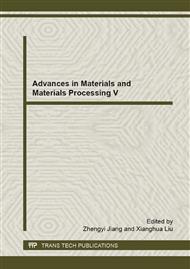[1]
Ma Ning, Hu Ping, Guo Wei, et al. Feasible methods applied to the design and manufacturing process of hot forming [J]. IDDRG2009 conference, Golden, CO USA, 2009, 835-843.
Google Scholar
[2]
Ma Ning, Hu Ping, Guo Wei. Technology and equipment of hot forming for ultra high strength steel [J]. Automobile & Parts, 2009(45): 28-30. (in Chinese).
Google Scholar
[3]
Altan T. Hot-stamping boron-alloyed steels for automotive parts [J]. Stamping Journal, December 2006, 40-41.
Google Scholar
[4]
Makinouchi A. Sheet metal forming simulation in industry. Journal of Material Processing Technology [J]. 1996, 60: 19-26.
DOI: 10.1016/0924-0136(96)02303-5
Google Scholar
[5]
Hu Ping, Rate-dependent quasi-flow corner theory for elastic/visco-plastic materials, Int. J. Solids & Struct., 2004, 41: 1263-1284.
DOI: 10.1016/j.ijsolstr.2003.09.013
Google Scholar
[6]
Avrami M. Kinetics of phase change І, general theory [J]. Journal of Chemical Physics, 1937, 7: 1103-1112.
Google Scholar
[7]
Nagasaka Y, Brimacobe J K, Hernendez-Morales B, et al. Mathematic model of phase transformation and elastoplastic stress in the water spray quenching of steel bar [J]. Metallurgical Transactions A, 1993, 24A(4): 795-808.
DOI: 10.1007/bf02656501
Google Scholar
[8]
Hsu T Y, Hongbing Chang. On calculation of Ms and driving force for martensitic transformation in Fe-C [J]. Acta Metallurgica, 1984, 32(3): 343-348.
DOI: 10.1016/0001-6160(84)90107-x
Google Scholar
[9]
Liu zhuang, Wu zhaoji, Wu jingzhi, et al. Numerical simulation of heat treatment processing[M]. Beijing: Science Press, 1996. (in Chinaese).
Google Scholar
[10]
Bergman G., Oldenburg M., A finite element model for thermomechanical analysis of sheet metal forming [J]. International Journal for Numerical Methods in Engineering, 2004, 59: 1167-1186.
DOI: 10.1002/nme.911
Google Scholar
[11]
Eriksson M, Oldenburg M, Somani M C, et al. Testing and evaluation of material data for analysis of forming and hardening of boron steel components [J]. Modelling Simul. Mater. Sci. Eng, 2002, 10: 277–294.
DOI: 10.1088/0965-0393/10/3/303
Google Scholar
[12]
Naderi M, Durrenberger L, Molinari A, et al. Constitutive relationships for 22MnB5 boron steel deformed isothermally at high temperatures [J]. Materials Science and Engineering A, 2008, 478: 130-139.
DOI: 10.1016/j.msea.2007.05.094
Google Scholar
[13]
Merklein M, Lechler, J. Determination of material and process characteristics for hot stamping processes of quenchenable ultra high strength steels with respect to a FE-based process design [J]. SAE World Congress: Innovations in Steel and Applications of Advanced High Strength Steels for Automotive Structures, Paper No. 2008-0853.
DOI: 10.4271/2008-01-0853
Google Scholar
[14]
XING Zhongwen, BAO Jun, YANG Yuying, et al. Hot stamping processing experiments of quenchable boron steel[J]. Material Science and Technology, 2008, 162:172-175.
DOI: 10.4028/www.scientific.net/msf.575-578.299
Google Scholar
[15]
LIN Jianping, WANG Liying, TIAN Haobin et al 2009. Research on hot forming behavior of ultrahigh strength steel. Journal of Plasticity Engineering, 16(2): 180-183. (In Chinese).
Google Scholar
[16]
MA Ning, SHEN Guozhe, ZHANG Zonghua. Material Performance of Hot-forming High Strength Steel and Its Application in Vehicle Body, Journal of Mechanical Engineering, 2011, 47(8):60-65. (In Chinese).
DOI: 10.3901/jme.2011.08.060
Google Scholar
[17]
Shaw,J., Watanabe,K., Steel Strength and Processing Effects on Impact Deformation for a Crash Energy Management Component, 2001, SAE Paper, 2001-01-1053.
DOI: 10.4271/2001-01-1053
Google Scholar
[18]
Huh,H., Kim K.P., Kim S.H., Song J.H., Kim H.S., Hong S.K., Crashworthiness assessment of front side members in an auto-body considering the fabrication histories, International Journal of Mechanical Sciences, 2003, 45: 1645-1660.
DOI: 10.1016/j.ijmecsci.2003.09.022
Google Scholar
[19]
MA Ning, HU Ping, ZAI Shuji, GUO Wei 2009. Technology and application of hot forming of high strength steel. Automobile Technology & Material, (12): 32-34. (In Chinese).
Google Scholar
[20]
Experiments and analysis of relations among heat, stress and transformation of boron steel for hot forming. Transactions of Materials and Heat Treatment, 2010, 13: 33-36. (In Chinese).
Google Scholar


